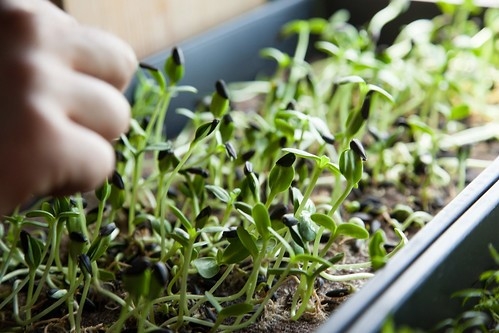Many all-natural gardeners tend to their indoor veggies this time of year. The hottest trend in indoor food production is growing “Microgreens.” They only need water, indirect sun, a flat container, and 3-4 weeks of growing before harvest. You can grow microgreens year-round; they are nutritionally dense (500-700% more than full-grown plants) and contain more antioxidants per ounce. They are also inexpensive to grow and packed with flavor. So, why not give them a try?
Microgreens are young edible vegetable or herb seedlings. Stems are 2-3 inches tall and have fully formed starter leaves, called cotyledons. These seedlings are packed closely together on trays or in hydroponic containers. They are in their first several weeks of life when you harvest them for food or garnish and require only water and indirect sun at this stage. They add fun and deliciousness to any meal.
Seed packets can be purchased in garden centers or online. They should be fresh (not past their packet expiration date), and organic (untreated). Store them in a cool, dark, dry place until you are ready.
You will need one or more flat, shallow (about 1-inch) growing trays with bottom holes for water drainage and absorption. Or you can use hydroponic trays with a fine mesh separating the seeds on top from the water supply below. You will also need a spray bottle for tap water spritzes, sterilized scissors, a growing spot with 10+ hours per day of indoor light (or a grow lamp), and tray covering material in the form of a dome for the first week or so. Aluminum foil works well.
For trays, purchase a sterile growing medium such as coconut coir, recycled cardboard, or jute to maintain consistent moisture. For hydroponic containers, you will need a growing pad cut to size or paper towels (but they dry out quickly), a hydroponic base of fine mesh screen, and a sterilized container.
Soak larger seeds overnight. First, mist the tray base with water. Add a sterile growing medium such as coconut coir. (Do not use potting soil or other fertilizer mixes, as seeds do not need them and produce an unpleasant off-taste in sprouts.) Evenly scatter about 1 teaspoon of seeds per tray. Mist the seeds and growing material with water until they are the wetness of a wrung-out sponge. Cover the container and check each day until nearly all seeds have germinated. Then remove the cover and place them in bright indirect sun. Maintain consistent moisture by placing the tray in a larger watertight container that holds standing water for the growing tray to absorb through its bottom holes.
Harvest time varies by plant type but generally, it is about two weeks after germination when seedlings are 1-3” tall and starter leaves are fully formed and green. Use scissors to clip seedlings just above soil level and wrap them in paper towels (without washing them). They are ready to eat, but they can be refrigerated for up to a week. Compost the remaining plant material and throw out the old growing medium. Sanitize reusable trays in a dishwasher.
Slower growing (18-26 days) microgreen varieties include radishes, beets, arugula, cabbage, peas, spinach, parsley, or herbs. Faster growing (10-15 days) types include arugula, broccoli, cabbage, kale, kohlrabi, mustard, amaranth, and spinach.
Slower growing (18-26 days) microgreen varieties include radishes, beets, arugula, cabbage, peas, spinach, parsley, or herbs. Faster growing (10-15 days) types include arugula, broccoli, cabbage, kale, kohlrabi, mustard, amaranth, and spinach.
Troubleshooting Grow Issues

Do seedlings look moldy? Those are their root hairs. Spray the seedlings with water, their roots will settle into the grow medium.
Are seedlings droopy? Add more water.
Are they looking leggy? Increase their light exposure or add a grow lamp.
Did they fail to germinate? Either the medium did not stay moist enough, air temperatures were too cold or hot (70 F. is ideal), seeds were low quality or expired, or the seeds were not stored properly before use. Try again.
Sprinkle on morning eggs, salads, pasta, taco salads, spring rolls, or use as a garnish on other entrees. Microgreens add nutrition, freshness, taste, and color to any meal. Grow your own all-natural microgreens for major benefits.
Seasonal Notes: Winter is a good time to trim out dead tree limbs and shape. Prune on dry days to allow the cut to heal properly.
Email your comments and questions to: NakedGardener@diablogazette.com.

